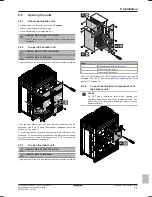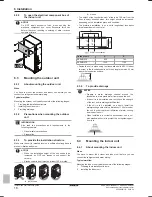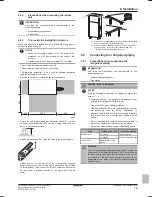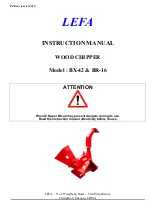
6 Installation
Installer and user reference guide
30
SERHQ020~0 SEHVX20~64BAW
Split packaged air-cooled water chiller
4P508020-1B – 2018.04
e
Indoor unit
The wiring for the other systems must be connected to the F1/F2
(Out-Out) terminals of the PCB in the outdoor unit to which the
interconnecting wiring for the indoor units is connected.
Fixing the transmission wiring
c
a
e
e
b
b
d
a
Heating/cooling switching remote control cord (when a
heating/cooling switch remote control (optional) is
connected) (ABC)
b
Fix to the indicated plastic brackets using field supplied
clamping material.
c
Wiring between the units (indoor - outdoor) (F1+F2 left)
d
Wiring between the units (outdoor - outdoor) (F1+F2 right)
e
Plastic bracket
NOTICE
Never connect the power supply to transmission wiring
terminal block. Otherwise the entire system may break
down.
NOTICE
Never connect 400 V to transmission wiring terminal block.
Otherwise the entire system may break down.
The wiring from the indoor units must be connected to the F1/F2 (In-
Out) terminals on the outdoor unit PCB.
NOTICE
Take care of the polarity of the transmission wiring.
The outdoor unit PC board (A1P) is factory set to "Sequential start
available".
6.9.7
To connect the power supply and
transmission cables
1
Open the electrical component box cover.
2
Using the appropriate cable, connect the power supply and
communication cable(s) to the appropriate terminals as shown
on the wiring diagram.
3
Fix the cables with cable ties to the cable tie mountings to
ensure strain relief and to make sure that they do not come in
contact with the piping and sharp edges. Never squeeze
bundled cables.
4
Close the electrical component box cover.
VRV
C2
VRV
C1
e
d
f
C2
f
C1
c
b
A5P
C2
A1P
C1
A3P
C1
X1M
K1P K1S
A8P
C2
X2M
X4M F1F2
F1F2
X3M
A6P
A4P
F1F2
F1F2
a
a
Switchbox
b
Outdoor unit 1
c
Outdoor unit 2 (only in case of 64BAW)
d
Pump
e
Switchbox
f
Evaporator
NOTICE
The power supply cable and the communication cable are
not included.
NOTICE
When installing the power supply wiring, also refer to the
figure in
"6.5.5 To connect the refrigerant piping to the
indoor unit" on page 22
.
6.9.8
Guidelines when knocking out knockout
holes
▪ To punch a knockout hole, hit on it with a hammer.
▪ After knocking out the holes, we recommend removing any burrs
and paint the edges and areas around the holes using repair paint
to prevent rusting.
▪ When passing electrical wiring through the knockout holes.
prevent damage to the wires by wrapping the wiring with
protective tape, putting the wires through field supplied protective
wire conduits at that location, or install suitable field supplied wire
nipples or rubber bushings into the knockout holes.
▪ When you do not use a wire conduit, protect the wires with vinyl
tubes to prevent the edge of the knockout hole from cutting the
wires.
b
c
a
a
Knockout hole
b
Burr
c
If there are any possibilities that small animals enter the
system through the knockout holes, plug the holes with
packing materials (to be prepared on-site)
















































